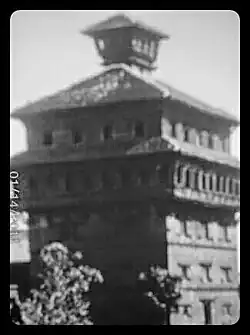| Manohara Durbar | |
|---|---|
 | |
| General information | |
| Architectural style | Neoclassical architecture and European styles of architecture |
| Town or city | Kathmandu |
| Country | Nepal |
| Completed | 1879 |
| Client | Jagat Jung Rana |
| Technical details | |
| Structural system | Brick and Mortar |
| Size | 500 Ropani |
Manohara Durbar was a seven-storied Rana palace in Manohara, Kathmandu, the capital of the Nepal. The palace complex was located 12 km southeast of the core of Kathmandu. It included a vast array of courtyards, gardens and buildings.[1]
History

Jagat Jung, who constructed the palace
Manohara Durbar was built in 1879 by Jung Bahadur Rana's son, Commanding General Jagat Jung Rana, as his private residence. After the murder of Jagat Jung in 1886, Manohara Durbar was used as a prison for royal women from both the Rana and Shah families found guilty of adultery.[1]
Current status
Even after the fall of the Rana regime, the ruins of Manohara palace could be seen until the late 1950s, but today the only remaining element from 1879 is a large pine tree.[1]
See also
References
This article is issued from Wikipedia. The text is licensed under Creative Commons - Attribution - Sharealike. Additional terms may apply for the media files.